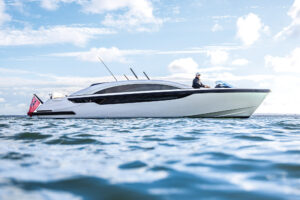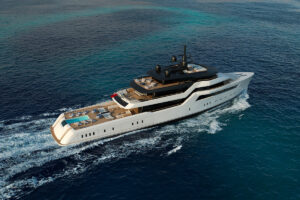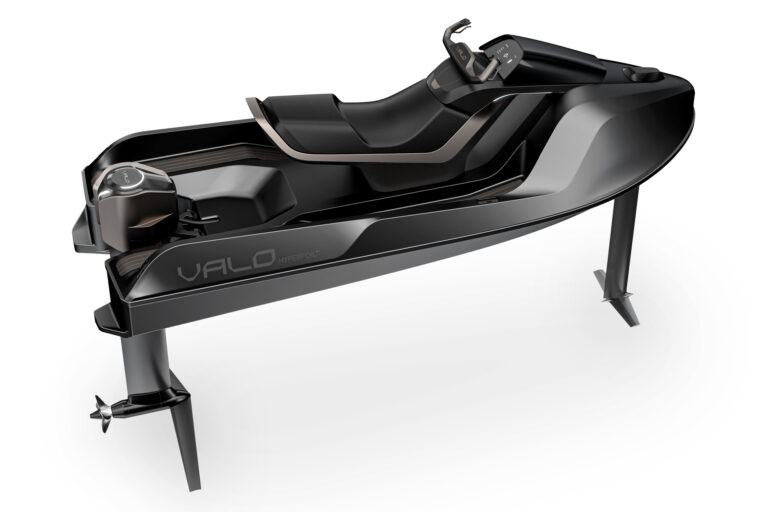Professional fishing crews make up a unique subculture that lies below the radar at marinas worldwide. Traveling from tournament to tournament on million-dollar-plus sportfishing yachts, the members of this cult incessantly clean and maintain their boats, sleep sporadically, cater to the whims of sometimes demanding owners, look out for one another and fish hard.
I was fortunate enough to sample the lifestyle when Hatteras Yachts invited me aboard its company boat, Hatterascal, crewed by the husband-and-wife team of Captain Terry and Bonnie Stansel, along with mate Greg Uff. While aboard, I learned that this well-balanced hull is fit for fishing and onboard comfort.
Hatterascal departed Palm Beach’s Sailfish Marina for the Bahamas, looking more like a yellow-hulled inter-island ferry than a 54-foot fishing machine. A household refrigerator was secured in the cockpit for island delivery, and a freezer and patio barbecue grill were lashed in the saloon. Eight 5-gallon pails of engine oil were stowed in the engineroom. Stores were packed tightly in every compartment, including the one under the saloon’s wide settee, proving that once on tour these crews are mostly self-sufficient.
This 54’s look and hull design are unlike any previous one by the builder, but with the synchronizer engaged and power applied to the lead Sturdy control on the pod helm, she shook off the added weight and assumed the familiar Hatteras bow-high running profile. She’s clearly a performance yacht, attentive to the ocean’s motion. With 4- to 6-foot swells and a 2-foot chop, slight movement of the wheel set her firmly into the wave pattern. Her convex hull has a sharp entry and widens to near-flat at the transom. Twin running strakes provide lift, and double chines forward effectively knock down and deflect spray.
The Gulf Stream crossing was of the best kind: uneventful. I was impressed when we passed a large sportfisherman, also headed to Marsh Harbour in the Abacos, making nearly 28 knots with a bridled 27-foot Contender in tow. Hatterascal cruised along at 32 knots; the 1,550 hp Caterpillar C30 engines were running at 1950 rpm at just 65 percent of their maximum load-even with the added cargo. As we reached the edge of the Bahamas Bank, Uff observed the green hue of the clouds as they reflected the color of the sand and shallow sea. To the east their color was the turquoise of the deep ocean.
Everyone in our five-member crew found a place on the fully outfitted flying bridge. Small touches such as drip moldings above all compartment doors keep interior spaces dry. Rod stowage is plentiful under the two settees. An optional electronics console drops from sight with the touch of a button. The electronic Caterpillar engine displays are on the tournament helm, and on Hatterascal a large video screen provides a view to machinery space. This is a comforting feature for long passages when just the Stansels are aboard, as Bonnie can easily monitor Terry’s frequent engineroom checks.
Something I had not seen before on any yacht was a set of air deflectors fixed on the rear of the hardtop. Their placement increases airflow to the bridge and eliminates any accumulating exhaust fumes.
This convertible is attracting customers who are currently running high-end center consoles and express boats. The 54’s handling will not scare off those moving up in LOA. With a draft of just more than 4 feet, the propeller pockets offer shallow running capabilities. As proof, we off-loaded the refrigerator to a waiting skiff in a very shallow Bahamas bay. Departing for Boat Harbour, lighter on fuel and with less cargo, Stansel jumped the 54 out of the hole with just 3 feet of water under her keel.
As expected, sound is slightly elevated on the bridge due to wind and wash, but it is an amicable melody, not an intrusive drone. Crew can easily pass behind the classic slot-back Murray helm chair without disturbing the captain. He in turn has full visibility and command of the extensive electronics package. The person who buys Hatterascal post-campaign will be happy to know Terry leaves his fish- and trip-route coordinates embedded in both Northstar GPS memories.
The tunnels did their job, and the next day, when the 54 was trolling at live-bait speed, the design kept prop wash to a minimum. The convertible can make way and maneuver under a knot, yet when a fish strikes, a quick bump out of trolling mode produces power for the hook set. At normal trolling speeds of 3 to 7 knots, the ballyhoo baits will still find clear water. Caterpillar provides a slow-idle button, and Stansel said that when docking he keeps the normal idle engaged to prevent any possibility of stalling the engines.
Our fishing was limited to a half-day, and though my professional crew tried trolling for pelagics and bait-fishing deep and shallow drops for snappers and grouper, the fish gods did not shine on us. The boat did shine, however-she sat well in the trough and responded to every command, including stemming the current over a piece of structure and feathering the edge of a weed line. The 33-knot cruising speed of Hatterascal provided us the luxury of covering multiple fishing areas. Some owners, especially those in the Caribbean, opt for the smaller, 800 hp engine package. They prefer the extended range; not everyone needs 40 knots in the corners. The smaller engines also plane the boat faster.
The Release fighting chair does not overwhelm the 149-square-foot cockpit. The freeboard is fishing friendly, and the transom has a large door sans gate, which keeps the covering boards uniform. Refrigerated stowage beneath the step to the saloon holds beverages and food.
My only complaint about the boat is that the scupper system allowed water intrusion into the cockpit while drifting, making for what I call “wet corners. Marketing Director David Ritchie indicated this concern had been identified and was being addressed on boats in the field and in production.
The saloon, staterooms and galley continue to reach the exacting standards the builder has set. Hatteras has eliminated engine hatches in the saloon, leading to impressive sound attenuation. The saloon is as quiet as can be, given that it sits atop 3,000-plus horsepower engines.
Eating on the fly is often the case, and Bonnie, who is a top-notch angler in her own right, moved adeptly about the galley while underway. The galley sole is Amtico, and counter areas are long and wide.
Hatterascal‘s three-stateroom, two-head layout works well. The washer and dryer are in the companionway leading to the forward stateroom, and my sleep was not disturbed as the wash cycled. A space-saving pocket door adds privacy to the starboard-side cabin with its side-by-side berths.
On the foredeck, an anchor locker stows docklines and fenders. Terry feels that once an owner has this feature he will never be without it. Many shun the bow rail completely for its sexy look, but Hatterascal is still sexy with her low-profile rail that is a comfort when docking and anchoring, as is the nonslip deck. Deck fuel and water fills are fabricated so they may be opened without a tool.
Space management is efficient. The Caterpillar C30s consume the engine compartment, but the room is still quite functional. Headroom is low but minimally inhibits accessing engine vitals or performing routine maintenance. The area outboard of the engines is tightly packed with compressors and the like. The space is brightly lit, expertly finished and neatly wired. Huge air plenums with filters ensure the big Cats breathe well.
Terry is partial to the C30s for their torque, ability to troll for long periods and what he perceives as a fish-friendly rumble. The underwater acoustics of the hull, engine exhaust and seven-blade propellers have proven successful at raising fish.
The hull has a solid bottom, and Divinycell coring is used on the hull sides, deck and superstructure. Hatteras fabricates many parts in-house, including shafts and struts. All tanks, including the two baffled UL-listed fiberglass fuel cells, also are made at the Hatteras plant. A transfer pump balances the load between them. The 24-volt service has two circuit panels: one in the cabin and one in the engineroom. They are logically spilt by function. Hatteras uses a five-step system to protect the bottom, but at 35 knots, not much will manage to stick to it.
Contact: Hatteras Yachts, (252) 634-4895; www.hatterasyachts.com.








